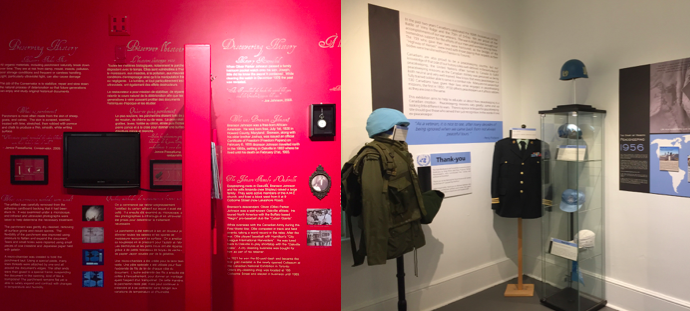From paint colour to publicity, a lot goes into designing museum exhibits. Here’s how to design displays that will please all audiences, regardless of age and interest.
- Aesthetics Create Atmosphere
When designing an exhibit, one must ensure that the interior design does not outshine the information. Harsh, vibrant colours often distract from the material at hand, making it difficult for visitors to focus on the provided content. Try to select muted, themed colour palettes that flow throughout the exhibit and create a cohesive style. Observe the photos below for examples of “distracting” colours versus “themed” colours. On the left, vibrant red paint overwhelms the exhibit, making it difficult to focus on the provided biographies. On the right, the clear colour scheme means that visitors are more likely to concentrate on the information at hand rather than feel overstimulated or overwhelmed.

- A Picture is Worth a Thousand Words
Take care to not overwhelm your display with paragraphs of information. Be sure to provide visual cues, as big blocks of text can become a daunting overload of new information. It is best to provide written content in a clear, streamlined fashion that indicates a distinct start and end point. By creating structure within your display, visitors are able to follow a clear timeline and historical story. Ensure that you provide relevant photos and artifacts, labelling when necessary to further engage visitors. Please see the image below for an example of an acceptable picture to text ratio.
- Interactivity is Key
Remember to engage your audience by designing displays that they can explore and discover on their own. Providing interactive components throughout exhibits can increase visitor interest by fostering a sense of curiosity and personalized knowledge. When directly interacting with content, visitors take away an individualized experience that is likely to stick in their memory. Try and incorporate video listening stations with headphones, artifact replicas, and moving displays that your visitors can experience and use.
- Don’t Forget About the Kids!
Always make sure you design exhibits that cater towards visitors of all ages. Incorporating game-based interactive technology and tactile displays is a great way to introduce younger audiences to history, as it makes the content more accessible and enjoyable. While interactive displays are great, always ensure that you provide direction as to the appropriate handling of objects. Let visitors know what they can and can’t touch through clear signs and labelling.
- Make it Cohesive
When creating the foundation of your exhibit, ensure that there is a clear and cohesive theme that links all sections of the display together. Audiences are more attracted to displays that tell a story. Make sure that the physical structure of your exhibit accurately represents the story you are trying to tell; place written stories in chronological order, draw connections between displayed artifacts and individual biographies, and more. Visitors should walk away from your museum feeling as if they have gained a better understanding of a topic, rather than mismatched fragments of information.
- Click to read more:
- Click here to learn more about The Oakville Museum’s displays featured in this article
- Find out more about interactive exhibits in this video from the Wall Street Journal
